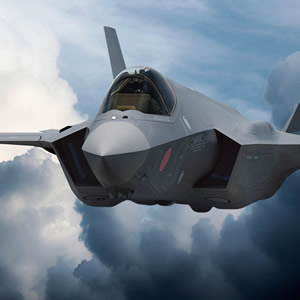Japan’s Kyodo News Service recently reported that Japan’s Ministry of Defense (MoD) projects that the cost for the Lockheed Martin F-35A Joint Strike Fighters (JSF) will be 50 percent greater than in the current year. The fifth-generation stealth fighters Japan has agreed to buy during Fiscal Year 2013 (FY13) may total as much as $196.9 million per aircraft instead of the current year cost of $128.6 million per plane.
Japan signed a formal letter of offer and acceptance (LOA) on 29 June to acquire four conventional take-off and landing (CTOL) variants of the F-35, spare parts, and two simulators for a total of $756.53 million. These four aircraft are scheduled for delivery in Fiscal Year 2016 (FY16). The cost of each of the initial four F-35As was estimated to be $128.61 million.
The MoD increased its FY13 budget request, submitted on 7 September, by $393.7 million to cover the cost of the first two aircraft. Since budget negotiations are in the early stages, media attention addressing the F-35A price increase has been minimal.
A stagnate economy and growing trade deficit have been a severe political strain on Prime Minister Yoshihiko Noda and the governing Democratic Party of Japan (DPJ). The government’s FY13 budget request is the largest in Japanese history and is likely to ignite intense criticism from political opponents especially with legislative elections expected to be held in November.
Additional F-35 price increases are not entirely unexpected considering the United States’ decision in January to reduce its 2013 order by 13 units and delayed orders on a total of 179 aircraft between FY13 and FY17.
The Japanese Air Self-Defense Force (JASDF) desperately wants to acquire a total of 42 F-35s to replace its outdated fleet of McDonnell Douglas F-4J Kai Phantoms.
In Japan recently, most media reports and public attention have been focused on territorial disputes with China, Taiwan, and South Korea and mass demonstrations in Okinawa protesting the deployment of Marine Corps MV-22 Ospreys.
The Japanese government is holding onto a glimmer of hope with Lockheed Martin and US Department of Defense (DoD) estimates that the F-35 costs will eventually come down to $78.7 million per aircraft. Those estimates are based on fulfillment of currently projected orders and does not take into account any additional development costs that may arise.
The territorial disputes with her Pacific neighbors, coupled with the Obama administration’s public pronouncements that the United States will not intervene in the disagreements, place increased pressure on Noda’s government to prepare the Japanese Self-Defense Force (JSDF) to stand alone in defense of territory Japan claims as its own. Japan’s existing fleet of combat aircraft is currently no match for China’s air combat force and the recent tensions arising from territorial disputes have intensified the Japanese government’s feelings of unease with respect to the nation’s ability to defend its sovereign territory.
Although Japan has a credible naval force and an air defense capability that was adequate to meet most challenges in years gone by, the rapid expansion of the military capabilities of Japan’s regional neighbors have highlighted her modern-day military weaknesses. Now more than ever, Japan’s political leaders are beginning to recognize that alone Japan cannot meet the challenges of the future unless her military is upgraded, modernized, and better trained.
Although the cost increases for the F-35 may generate a short-lived political outcry, it is unlikely Japan will cancel its order in favor of a competing aircraft. China’s military advances in recent years are likely to convince the Japanese to stick with the F-35. Of course, anything is possible and the November elections might sweep the Liberal Democratic Party (LDP) back into power and past decisions might be overturned.

















